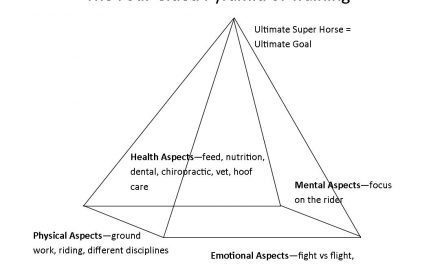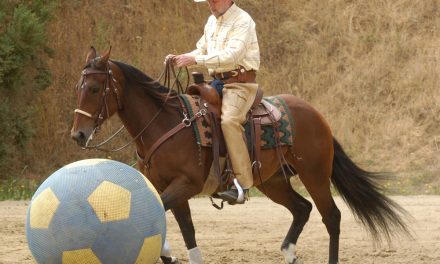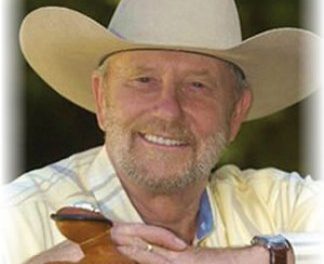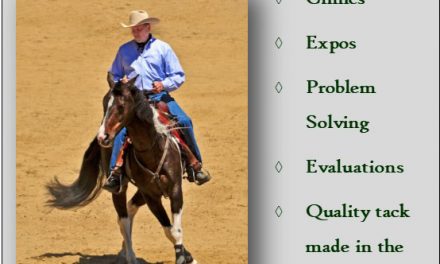
Thirty years ago, when I was doing round pen training, few people knew what a round pen was. If you were working in a round pen, you looked like an idiot that didn’t know what you were doing other than running a horse around in circles. Fifteen years ago, more people were aware of natural horsemanship and it started to have an influence in the horse world. Ten years ago, it really started taking hold and now you see natural horsemanship techniques, in some form or another, used widely everywhere in training programs. I remember at Horse Expos I attended ten years ago, I was the only guy out there with a blue tarp and people were wondering what in the world I was going to do with it. People did not understand the concept that the tarp represented a scary object and the benefit of getting a horse to accept that kind of pressure. There is always something out there that will raise the emotional level of a horse. A tarp is an object that will raise pressure and help a horse learn to accept it. To “accept it” meaning the horse will walk onto a tarp and stand there on its own, paw it and pull it around its feet. A lot of people think that “accepting” is when a horse will walk over a tarp. I remember being told five years ago that, “Oh, my horse goes over a tarp” meaning the horse would trot or run over a tarp. That is a start but that is not total acceptance. Acceptance is dropping the nose and recognizing the tarp, standing on it and being quiet and soft in the body and the eyes. I like a horse to start pawing on a tarp because when they paw it and start gathering it around themselves they are truly relaxed.
Thirty years ago, when I would travel to the east coast, they would say, “Oh, you’re the blue tarp guy.” Now when I go to Horse Expos, every trainer has a blue tarp. We are starting to see that natural horsemanship has influenced training in that there is a recognition that horses do have emotions (the flight instinct), and that the way that we handle that emotion is to introduce a horse to scary objects and work with the horse to accept the objects instead of bucking or bolting away from them. The result of this training is that ground manners are better and horses are more emotionally sound and safer under saddle.
Unfortunately, I am also seeing a negative side of this picture. Most of us in the business use a string or rope halter, what I call a cowboy halter. People see us get the desired results and buy a cowboy halter, take it home but do not get the continued magic. The reason is that it is not the equipment that trains the horse. We use that type of halter because it has a little bit more bite or feel than a web or leather halter that is wider. A string halter definitely catches the attention of a horse and a horse will be more willing to come off it. People buy these halters and for the first week the halter works like magic. Then suddenly, the magic is gone. The horse doesn’t have any more respect for the string halter than it had for a web halter. Also, because it is not the equipment that trains the horse, the horse is not going to care if he is worked on a six, 12 or 14-foot line. It isn’t the equipment but how we use it. An individual may think that he or she is following natural horsemanship but, because the principle of pressure and release is not really understood, no change is made in how the equipment is used and the horse just becomes dull. If the exercise is done properly, it doesn’t matter if a leather or web halter is used as it is really what we do with it. In the last five years, I have had many horses brought to the ranch for issues with ground manners. Because of the improper use of a string halter, these horses are really dull and it is very hard to get them light again. When a horse has learned to lean on that type of halter, there is not much I can do to apply additional pressure that can then be released when the horse responds.
The equipment has influenced the market but what I see is that the timing and feel in the use of the equipment have not influenced the market. Timing and feel are things that can only be taught through trial and error. One thing I tell my clients at the ranch is if it feels ugly in your hand, it feels heavy and uncomfortable, then you are not using the equipment properly. If you are riding a horse and you pick up a rein, you don’t want the horse pulling on you. You want the horse to respond to a light cue but if the horse doesn’t respond, you must increase the pressure. The horse is resisting because it is a horse’s basic nature and make up to resist. Some horses resist more than others, just like people, because each horse is an individual. The problem is that people use equipment without either the knowledge or understanding of pressure and release. For example, when a person continually uses a stud chain to control a horse, it is hard to get that horse soft again. Because the horse has learned to lean on the chain, getting the horse to be obedient and give to pressure around the face is difficult.
Any piece of equipment, including a stud chain has a place but there is a problem when we rely solely on that equipment to train a horse. If I am backing up or leading a horse that is pulling on me, I will not release the pressure until I get the desired action from the horse, even if it is only one step. That is the way a horse learns and that is a basic principle that I teach. The only exception to that rule is in a situation where I will get hurt or the horse will get hurt if I don’t release the pressure. Until that point, I will not release the pressure until I get some kind of give from the horse.
More next time on the influence of natural horsemanship.




